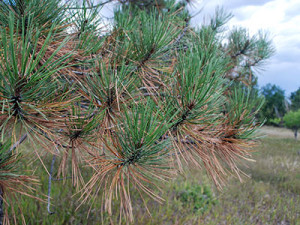
FORT COLLINS, Colo. – Although thousands of evergreen trees in many areas of Colorado are beginning to display dying yellow or brown needles, most are simply going through a natural shedding process – and are not infested by bark beetles or tree disease.
Every autumn, many Colorado evergreens shed some of their older, interior needles as part of an annual growth cycle. Needles on the lower portion of the crowns or closest to the trunk are most commonly shed, but trees stressed due to drought or root damage may shed more needles to keep the tree in balance with its root system.
Soon-to-be shed needles typically turn yellow first, then a reddish-brown color before dropping off; very small branches with few needles on them also may die.
“Needle Cast” Different From Beetle-Infested Trees
Evergreen trees that shed fall needles have a different appearance than trees infested by bark beetles. The needles on a beetle-infested tree typically change color throughout the entire tree, initially starting with an off shade of green and turning to reddish-orange by the following summer. In addition to changing needle colors, bark beetle-infested trees also will show other signs of attack, such as popcorn-shaped resin masses on the trunk, fine sawdust collecting in bark crevices and at the base of the tree, and regular woodpecker activity.
Seasonal discoloration (yellowing pine needles) and loss of pine needles frequently is called “needle cast,” but the term actually refers to several fungal diseases affecting conifers, including pine, spruce and fir.
For more information about tree and forest health, contact your local CSFS district or field office.

